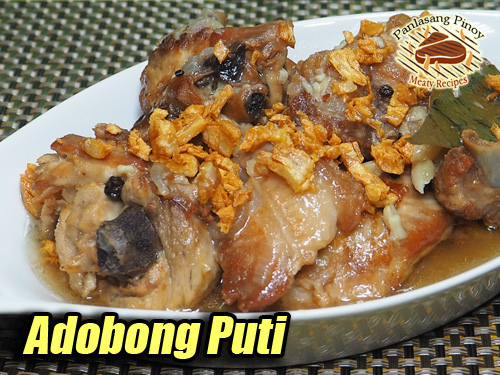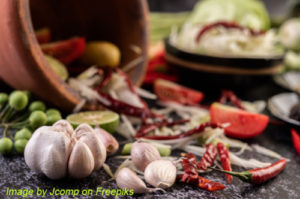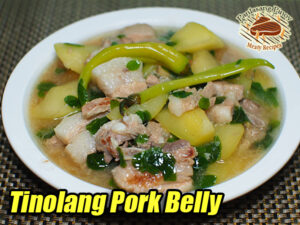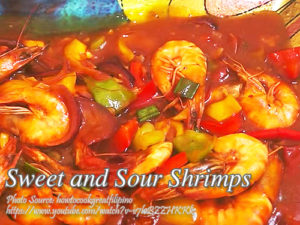Adobo sa puti is the white version of the traditional adobo. The reason why it is white is because it doesn’t contain soy sauce that turns an ordinary adobo into dark brown color. Instead of combining soy sauce and vinegar when cooking adobo, only vinegar and salt is used. The vinegar is the primary ingredient that gives the dish its sour taste, and the garlic adds a delicious aroma and flavor. Of course the spices (peppercorns, bay leaves) and other condiments is included and essential in cooking this dish. It can be served with rice and is a one of the popular dish in the Philippines.
The cooking procedure is almost the same as the usual adobo but there is a additional process in cooking it. First, boil the meat in water with vinegar, garlic, peppercorns and bay leaves. Drain, reserve the liquid and fry the meat. Then return the broth to the meat and simmer until liquid is reduced to half. Although this dish is not the same as the one served in Ibayo (by Barrio Fiesta), if you are craving to eat this dish, I guess it will not harm you to cook to satisfy your craving.
Discovering the Unique Flavors of Adobo sa Puti
If there’s one dish that brings me back to my childhood kitchen, it’s adobo sa puti. Unlike the classic adobo, which is rich and brown from soy sauce, it is refreshingly light and clear, allowing the natural flavors of vinegar, garlic, and bay leaves to shine through. My uncle Tito Boy, a master in cooking adobo variations, first introduced me to this white adobo. “Mas simple, mas malasa,” he would say—”simpler, more flavorful.” And, as I’ve come to learn, he was absolutely right. This dish brings out the nostalgia of simpler times, and it’s perfect for anyone who’s looking to get a taste of tradition.
What Makes Adobo sa Puti Special?
So, what’s the secret to this delicious yet underrated Filipino dish? Adobo sa puti skips soy sauce, the ingredient that usually darkens the traditional adobo, giving it that signature color and rich umami flavor. Instead, it relies solely on vinegar and salt, giving it a distinctive tang and purity that highlights the natural taste of the meat. This technique of using vinegar as the primary flavoring is believed to be an earlier, more traditional way of cooking adobo before soy sauce became common in Filipino kitchens.
It’s fascinating to think of this version of adobo is a “white” version of adobo, yet it remains just as hearty and satisfying as its darker counterpart. The adobo dish truly lets the vinegar’s sharp, clean flavor shine through, while the garlic, peppercorns, and bay leaves give it an aromatic depth that’s both comforting and distinctively Filipino.
Preparing the Ingredients for Adobo sa Puti
For this dish, my family usually combines pork and chicken to add a bit of variety. The mix of meats provides a more complex texture and makes each bite a little surprise. My mom, Nanay Tess, swears that the blend of pork and chicken makes adobo sa puti even more flavorful, especially when the pork fat renders and mixes with the sauce. To start, you’ll need basic ingredients—pork, chicken, vinegar, garlic, bay leaf, salt, peppercorns, and water. These ingredients come together so simply yet so perfectly.
This dish relies heavily on vinegar, and it’s best to use a good-quality one. My cousin Lito, who always has kitchen hacks up his sleeve, taught me that letting the vinegar simmer without stirring too much can help it cook off its sharpness, resulting in a smoother, more balanced tang. This is the kind of advice that makes you realize Filipino cooking is as much about technique as it is about ingredients.
Step-by-Step: Cooking to Perfection
Cooking adobo sa puti isn’t all that different from the traditional adobo, but there’s an additional process that makes it uniquely delicious. The first step is to bring the pork and chicken to a boil with the vinegar, garlic, peppercorns, bay leaves, and water. As the mixture simmers, the flavors meld together and the vinegar infuses the meat, tenderizing it and giving it that distinct tangy bite.
Once the meat is tender, drain it from the broth. Here’s where the technique gets interesting: heat some oil in a pan and deep-fry the pork and chicken pieces until they’re golden and crispy on the outside. Frying the meat adds a layer of texture, giving the dish that extra savory crunch that makes each bite memorable.
After frying, return the broth to the pan with the meat and let it simmer again until the liquid has reduced to about half. This reduction process intensifies the flavors, giving the broth a slightly thicker consistency and a wonderfully concentrated taste. My auntie Linda always tells me to be patient at this stage, as letting the sauce reduce naturally brings out a fuller flavor without the need for extra seasonings.
Serving Suggestions and Family Tips
Once the it has simmered down to a flavorful, slightly thickened broth, it’s ready to serve. I love pairing this dish with a side of fresh tomato salad, just like my mom used to do. The juicy tomatoes add a burst of freshness that cuts through the richness of the meat and vinegar sauce. Serve the dish hot with a steaming plate of rice, and you’ll have a meal that’s hearty, comforting, and full of flavor.
Another tip from my cousin Lito is to let the dish sit for a few hours before serving, or even overnight in the refrigerator. Adobo in any form tends to taste even better the next day, as the flavors continue to deepen and meld together. There’s something special about leftovers, and this is no exception. Reheat it gently, and it’s as if the flavors have grown richer, the sauce more velvety.
A Little History of Adobo sa Puti
While many people are familiar with the soy sauce-based adobo, the idea of a white adobo isn’t as widely known. It may actually be closer to the original pre-colonial Filipino adobo, which was cooked using only vinegar and salt as natural preservatives. This method allowed food to last longer in a tropical climate, where refrigeration was not available. Over time, regional variations emerged, and soy sauce was introduced, likely due to Chinese influence. This addition created the darker adobo that we now know as the classic version.
Yet, there’s a special charm in revisiting this version of adobo. Its simplicity and bright flavor are a beautiful reminder of the way our ancestors may have enjoyed this dish, long before other ingredients were added to the Filipino pantry.
Why Adobo sa Puti Deserves a Spot at Your Table
Adobo sa puti may not be as common as its darker counterpart, but it’s a dish that every Filipino should try. It’s simple to make, wonderfully satisfying, and has a unique tanginess that makes it stand out. If you’re new to cooking Filipino food, this white adobo is an excellent dish to start with. It brings the essence of traditional Filipino flavors into one pot, and the steps are easy enough for beginners.
Give it a try, and let its bright, tangy flavor take you on a journey back to the heart of Filipino cooking.
How to Cook Adobo sa Puti (White Adobo)
Ingredients
- 1/2 kilo sliced chicken
- 1/2 kilo liempo or pork belly cubed
- 1 cup white vinegar or palm vinegar
- 2 heads garlic crushed
- 1 pc bay leaf
- 1 tablespoon rock salt
- 5 pcs peppercorn cracked
- 1 cup water
- cooking oil
- 1 teaspoon white sugar
Instructions
How to cook adobo sa puti:
- Combine pork, chicken, vinegar, garlic, bay leaf, salt, peppercorns, and water in a casserole.
- Let boil and lower heat. Simmer until tender. Drain the pork and chicken pieces from the broth.
- Heat oil and deep fry pork and chicken pieces. Return to the broth.
- Simmer until liquid has been reduced to half. Add the sugar and adjust seasonings to taste.
- Serve hot with tomato salad.
Video
Notes
Cooking Tips:
- Marinating for Flavor Infusion: To intensify the flavors, consider marinating the meat in the vinegar and garlic mixture for a few hours or even overnight before cooking. This allows the meat to absorb the tangy essence of the vinegar and the aromatic flavors of the garlic. Marinating not only enhances the taste but also helps to tenderize the meat, resulting in a more succulent and flavorful dish.
- Adjusting the Vinegar Ratio: The amount of vinegar used can be adjusted to suit your personal taste preferences. If you enjoy a more pronounced tanginess, increase the amount of vinegar in the recipe. On the other hand, if you prefer a milder flavor, reduce the vinegar quantity slightly. It's important to find the right balance to achieve the desired level of sourness that complements the other ingredients. Remember, cooking is an art, and customization is key to creating a dish that suits your palate.






Hi Christian, thanks for your comment and I’m glad you liked the recipe!
Cooking white adobo right now with your recipe Sir Manny! Pero Chicken lang ginamit ko! Ang bango!
Nice n easy to cook
sir pwede rin ba lagyan ng potatoes? nasanay kasi kami may potatoes e. thanks! 🙂
Pwede rin po lagyan ng patatas.
I’m curious to the taste of this adobe, I will try to cook this soon.